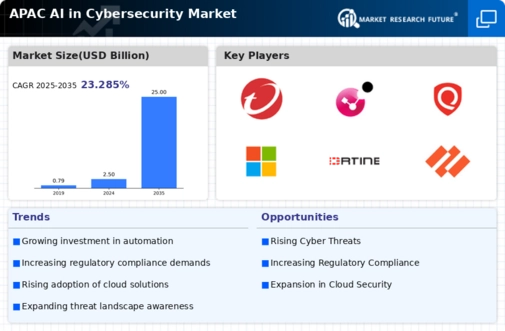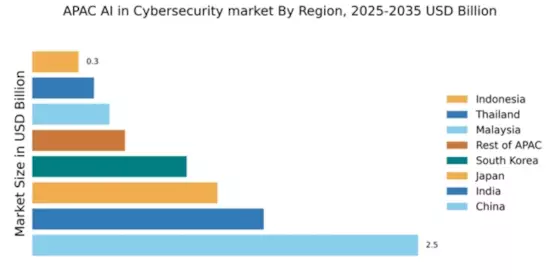China : Rapid Growth and Innovation Hub
China holds a commanding 2.5% market share in the AI in-cybersecurity sector, driven by robust government initiatives and increasing cyber threats. The demand for advanced cybersecurity solutions is fueled by the rapid digital transformation across industries, including finance and e-commerce. Regulatory policies, such as the Cybersecurity Law, promote data protection and compliance, while significant investments in infrastructure bolster the market's growth potential. The industrial development in tech hubs like Shenzhen and Beijing further enhances the demand for AI-driven security solutions.
India : Strong Demand and Investment Growth
India's AI in-cybersecurity market is valued at 1.5%, reflecting a surge in demand driven by increasing cyber threats and digitalization across sectors. The government's Digital India initiative encourages investments in cybersecurity infrastructure, while regulatory frameworks like the Personal Data Protection Bill aim to enhance data security. The growing startup ecosystem in cities like Bengaluru and Hyderabad is also contributing to innovative cybersecurity solutions, catering to both local and global markets.
Japan : Focus on Advanced Solutions
Japan's market share in AI in-cybersecurity stands at 1.2%, supported by a strong emphasis on technological innovation and a proactive approach to cybersecurity. The government has implemented policies to enhance national security, including the Cybersecurity Strategy, which promotes collaboration between public and private sectors. The demand for AI-driven solutions is particularly high in sectors like manufacturing and finance, where data protection is critical due to the increasing digitization of operations.
South Korea : Government Support and Industry Growth
South Korea's AI in-cybersecurity market is valued at 1.0%, driven by a strong regulatory framework and government support for cybersecurity initiatives. The Cybersecurity Act mandates organizations to adopt advanced security measures, fostering a culture of compliance. Key cities like Seoul and Busan are emerging as cybersecurity hubs, attracting major players like IBM and Cisco. The competitive landscape is characterized by a mix of local startups and established global firms, focusing on sectors such as finance and telecommunications.
Malaysia : Investment in Digital Security
Malaysia's market share in AI in-cybersecurity is 0.5%, reflecting a growing awareness of cybersecurity threats among businesses. The government has launched initiatives like the National Cyber Security Strategy to enhance the country's cybersecurity posture. Demand is increasing in sectors such as finance and healthcare, where data protection is paramount. The competitive landscape includes both local firms and international players, with Kuala Lumpur being a key market for cybersecurity solutions.
Thailand : Focus on Compliance and Protection
Thailand's AI in-cybersecurity market is valued at 0.4%, driven by increasing cyber threats and a focus on regulatory compliance. The government has introduced the Cybersecurity Act to enhance data protection across industries. Key markets include Bangkok and Chiang Mai, where businesses are increasingly investing in cybersecurity solutions. The competitive landscape features both local and international players, with a growing emphasis on sectors like finance and e-commerce.
Indonesia : Rising Demand and Investment
Indonesia's market share in AI in-cybersecurity is 0.3%, reflecting a burgeoning demand for cybersecurity solutions amid rapid digital transformation. The government is promoting cybersecurity through initiatives like the National Cybersecurity Strategy, which aims to protect critical infrastructure. Key cities such as Jakarta and Surabaya are witnessing increased investments in cybersecurity technologies. The competitive landscape includes both local startups and global firms, focusing on sectors like finance and telecommunications.
Rest of APAC : Varied Market Dynamics Across Regions
The Rest of APAC holds a market share of 0.6% in AI in-cybersecurity, characterized by diverse market dynamics and varying levels of cybersecurity maturity. Countries in this sub-region are increasingly recognizing the importance of cybersecurity, driven by rising cyber threats and regulatory pressures. The competitive landscape includes a mix of local and international players, with key sectors such as finance, healthcare, and government driving demand for advanced cybersecurity solutions. Each country presents unique challenges and opportunities for market players.


















Leave a Comment